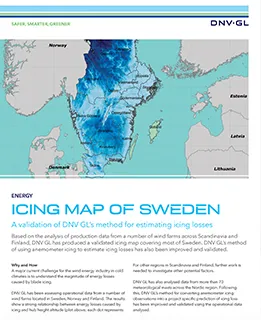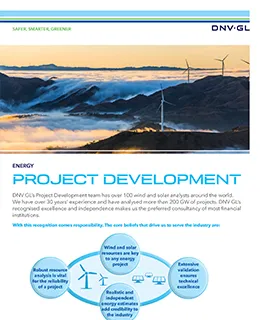The challenge of predicting icing losses
In cold climates, the performance of wind turbines may be significantly reduced by ice accretion on the turbine blades. The magnitude of production loss can reach over 50% during winter months, and exceed 10% on an annual basis. Therefore, the impact of icing on turbine performance is a challenge for developing and operating wind farms in cold climates.
The ability to correctly estimate future icing losses is of critical importance. This is an area that has seen substantial research & development (R&D) effort in the past few years from the entire wind industry and several sophisticated models (atmospheric and others) have been developed.
However, uncertainty remains around the accuracy of these models, as validation is still limited and there is currently no industry wide agreed approach to estimate these losses.
In order to overcome these challenges, a validated method is needed to quantify the impact of icing on the performance of wind farms in cold climates and to understand the variability and inherent uncertainty in these predictions. DNV has assessed data from over 30 operational wind farms and more than 90 meteorological masts located in the Nordic region and has been presenting the findings of this ongoing study to the industry every year.
Icing map of Sweden
A strong polynomial relationship between hub height altitude and icing loss was found for many Swedish wind farms included in the study. The relationship between altitude and icing was observed to be different for coastal Norwegian sites, Northeast Sweden and those in Finland, suggesting the icing climate seems to increase in severity eastwardly. From this relationship, an icing map of Sweden has been developed which applies this function to the topography of the country.
Some areas of Sweden have been excluded. For these areas and for Norway and Finland, further work is needed. The map is reasonably representative of long-term conditions as the production data used spans over a period of at least seven years.
Estimating icing losses for other areas in the Nordic region
For sites in the Nordic region outside the map, DNV’s study demonstrates that the estimate of ice loss can rely on the correlation between icing in anemometer mast data and production losses.
Following the analysis of the icing observed in pre-construction data and the energy loss due to icing in operational turbines, a methodology using anemometer icing in pre-construction data to predict icing losses during wind farm operation has been presented. The annual icing loss predicted using this method is validated against the production data. The method depends on icing observed in on-site unheated cup anemometer data and not on altitude. The method is therefore applicable even for sites where the altitude is not the main driver for icing.
DNV is currently working on the applicability of this methodology for other cold climate regions.




